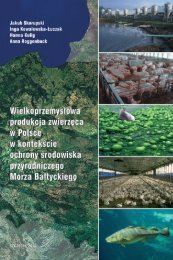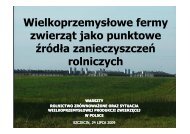best available technologies for manure treatment - Baltic Green Belt
best available technologies for manure treatment - Baltic Green Belt
best available technologies for manure treatment - Baltic Green Belt
You also want an ePaper? Increase the reach of your titles
YUMPU automatically turns print PDFs into web optimized ePapers that Google loves.
Best Available Technologies <strong>for</strong> <strong>manure</strong> <strong>treatment</strong> baltic sea 2020<br />
3: INFORMATION GATHERED<br />
3.3: Community plants <strong>for</strong> livestock<br />
<strong>manure</strong> <strong>treatment</strong><br />
Technologies that are not stand-alone <strong>technologies</strong><br />
and/or have clear economies of scale would typically<br />
have an advantage of being implemented via farmer<br />
cooperations or a service provider as off-farm <strong>manure</strong><br />
<strong>treatment</strong> plants.<br />
• Technologies that cannot stand alone would often<br />
be part of rather complex and high-tech solutions<br />
that would be complicated <strong>for</strong> farmers to handle<br />
along with their key production.<br />
• Technologies with a clear economy of scale, i.e.<br />
where <strong>treatment</strong> of a small amount per year is<br />
more costly than <strong>treatment</strong> of a large amount per<br />
year, see <strong>for</strong> instance Birkmose (2006), would<br />
often be too costly <strong>for</strong> farms of average sizes to<br />
invest in and to operate.<br />
Examples of these cases are livestock <strong>manure</strong> <strong>treatment</strong><br />
plants, where pig slurry is converted to purified<br />
water and different commercial/mineral fertilisers, <strong>for</strong><br />
instance nitrification-denitrification plants as seen in<br />
Spain, Holland and Belgium, purification plants as<br />
seen in Holland, or centralised biogas plants as seen<br />
in Denmark.<br />
Further, it is important <strong>for</strong> farms to handle risks<br />
associated with their business, and the larger investments<br />
they make in relation to their turnover, the<br />
more vulnerable are they to changes in the markets,<br />
regulations and other external factors.<br />
Remarks given by participants at the Roundtable<br />
discussion on 29 September generally expressed the<br />
opinion, that the project could promote larger community<br />
livestock <strong>manure</strong> <strong>treatment</strong> plants <strong>for</strong> combined<br />
<strong>technologies</strong>. This would take away the structural<br />
development pressure on pig producers, which would<br />
be a result in itself in relation to the environmental<br />
load of pig production. The rationale behind the<br />
remarks is that the structural development in the<br />
livestock production is <strong>for</strong>ced by the legislative burden<br />
on the producers, which more rationally can be dealt<br />
with by the large production units than the smaller<br />
ones. Furthermore, if the legislative burden en<strong>for</strong>ces<br />
use of specific <strong>technologies</strong>, then the economy of scale<br />
of the technology would <strong>for</strong>ce the smallest producers<br />
to go out of the market. It is also of importance <strong>for</strong><br />
many pig producers to develop their competences on<br />
animal husbandry, and to source out other activities, as<br />
<strong>for</strong> instance livestock <strong>manure</strong> <strong>treatment</strong>. There<strong>for</strong>e, by<br />
encouraging the livestock <strong>manure</strong> <strong>treatment</strong> <strong>technologies</strong><br />
as community plant solutions, would avoid an<br />
extra pressure <strong>for</strong> livestock farms <strong>for</strong> growing bigger in<br />
order to survive. The extra transport of slurry to and<br />
from a community plant would typically be balanced<br />
by advantages of a more rational slurry handling,<br />
increased value of the slurry etc. within a certain radius<br />
from the community plant.<br />
Additionally it should also be kept in mind that<br />
a major challenge with an environmentally sound<br />
disposal of the livestock <strong>manure</strong> is to distribute it at<br />
sufficiently large areas of agricultural land, as visualised<br />
in tables 1 to 4. There<strong>for</strong>e, a major advantage<br />
of community plants are actually, that they in reality<br />
functions as centres <strong>for</strong> regional re-distribution of<br />
livestock <strong>manure</strong>s, meaning that the logistics around<br />
the collection of pig slurry and distribution of treated<br />
<strong>manure</strong> ensures the distribution to <strong>for</strong> instance specialised<br />
plant producers without livestock production<br />
in the region. See also www.biovakka.fi.<br />
However, the off-farm livestock <strong>manure</strong> <strong>treatment</strong><br />
plants are actually moving the livestock <strong>manure</strong> <strong>treatment</strong><br />
from being a regulated issue to a non-regulated<br />
issue, at least in some cases. The IPPC directive does<br />
not, via the Annex 1 list of installations that needs<br />
environmental approvals, comprise off-farm livestock<br />
<strong>manure</strong> <strong>treatment</strong>.<br />
Off-farm livestock <strong>manure</strong> <strong>treatment</strong> plants should<br />
be listed in Annex 1 of the IPPC Directive as installations<br />
that require environmental approval because the<br />
deployed <strong>technologies</strong> have environmental impacts in<br />
general, and on N and P leaching in specific.<br />
3.4: Efficiency of BAT dissemination in<br />
relation to the IPPC Directive<br />
The following sections give a presentation of the<br />
in<strong>for</strong>mation gathered about the IPPC Directive,<br />
how the administration of it is organised, and of the<br />
BREF document.<br />
Additionally, reference is given to the annexes<br />
C and J with lists of people met and memorandum<br />
from roundtable discussion.<br />
27








